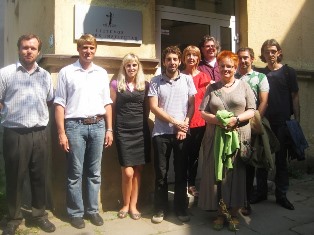
The purpose of the workshop was to discuss methodological aspects of the collection of data and statistics to be searched to assess the current status of penitentiary systems and policies of the five EU target Member States (Belgium, Bulgaria, Germany, Lithuania and Spain) as well as the application and scope of alternatives to sentences of imprisonment used in this countries.
Questions at the center of this meeting included: 1) What exactly falls within the scope of “re-socialisation” of offenders? 2) What is the actual role of the prison system and in particular to what extent the prisons should be responsible for the re-socialisation of offenders having in mind that there are other institutions with responsibilities in this area? 3) What exactly falls within the scope of “offender”? 4) How to assess the role of the civil society in the work of the penitentiary system? Which NGOs perform work in prison? 5) Which are the most relevant and reliable statistical indicators?
What exactly falls within the scope of “re-socialisation” of offenders?
On the one hand, there is the more or less narrow understanding of the policy makers who tend to understand re-socialisation as equal to prevention of re-offending, i.e. if a person does not commit a crime after his or her release from the prison then he or she has to be considered as successfully re-socialised. On the other hand, there is the broader understanding that criminal penalties in general and imprisonment in particular should have a wider impact on the offender. According to this understanding, the prevention of re-offending, although undoubtedly important, should not be regarded as the only objective of imprisonment. A prison sentence should have as its purpose to re-educate the offender and contribute to its successful social re-integration, bearing in mind that a significant share of the prisoners comes from marginalised groups.
What is the actual role of the prison system and in particular to what extent the prisons should be responsible for the re-socialisation of offenders having in mind that there are other institutions with responsibilities in this area?
Currently the prisons are often expected to provide the prisoners with extra knowledge and skills that the inmates have not possessed before. For example, the prisons are usually responsible for ensuring that during their stay in prison the inmates can study or attend professional qualification courses. Thus, in a way, the prison system is overloaded with increased expectations that it could compensate for the lack or the inefficiency of other mechanisms for the integration of marginalised groups. And if the prisons fail to meet these expectations, usually due to the lack of adequate resources, they are risk to get blamed for a failure that is not their natural responsibility.
What exactly falls within the scope of “offender”?
Due to the differences between the national legal systems it appears that the term ‘offender’ can have different meaning in different countries. The only category of persons that is always defined as ‘offenders’ are the individuals that have been sentenced by a court for a criminal offence. However, there are other groups of persons with more or less similar characteristics, whose inclusion in the term ‘offenders’ is not always undisputed.

The second group consists of persons detained in custody without a conviction. This group includes the pre-trial detainees kept in custody in the course of criminal proceedings as well as some other groups of individuals that are detained under specific procedures (e.g. police detention). The situation of such persons resembles that of prisoners because they are deprived of their liberty in relation to criminal offence. The difference is that the prisoners are convicted (their guilt has been proven) while the other categories are placed in detention due to the assumption that they have committed an offence (they are innocent unless proven guilty). Again, similarly to the detention centres for migrants, the pre-trial detention facilities and the prisons reveal some common problems (overcrowding, poor conditions, etc.). Moreover, in many countries pre-trial detainees are accommodated in the prisons, although under a different regime due to their presumed innocence.
The third group includes the persons accommodated in psychiatric hospitals because they have committed a crime with the exception of those whose psychiatric problems exclude their criminal responsibility. The major problem here comes from the fact that the legal framework governing the treatment of offenders with such problems significantly differs from country. In some countries such persons could be sent to a psychiatric hospital by the court (with the sentence) and this hospital could be outside the prison. In other countries this could be done by the prison administration (with or without the intervention of the prosecutor or the court) but the hospital must be part of the prison system. Also, legal frameworks differ from country to country in terms of whether the stay in a hospital is counted as imprisonment or not.
How to assess the role of the civil society in the work of the penitentiary system? Which NGOs perform work in prison?
The major problem in this respect is that many NGOs are doing some prison-related work and there is no centralised source of information about their activities. Some small NGOs often work with individual prisons without necessarily passing through the central managerial body of the system. Also, due to the fact that the majority of such activities are based on projects, they are far from regular and could easily cease and then be re-launched when funding is again available. The problem is even bigger in countries like Germany and Spain with higher degree of decentralisation due to their federal form of government. A possible solution to the problem would be to search for some formal institutions or procedures that might help identify the major civil society organisations active in this field. Such formal institutions and procedures might be registers of NGOs working in the prisons, if such are kept by the prison administration, participation of NGOs in public councils or task forces dealing with the prison system, etc.
Which are the most relevant and reliable statistical indicators?
Participants agreed that each country data should be collected for a longer period of time (since 2004). This would allow the identification of specific trends and developments related to the prison population, the capacity of prisons, the overcrowding and the profile of prisoners (age, gender, etc.). Specific attention was paid to specific individual statistical items, such as whether flow or stock data are more reliable and to what date the stock data would be more reliable, or indicators, such as “average length of factual imprisonment” used by some prison administrations to show the difference between the duration of imprisonment according to the sentence and the one actually served in prison, or the age profile of prisoners, in particular juveniles (considering that legal framework of juvenile justice differ substantially from country to country).






